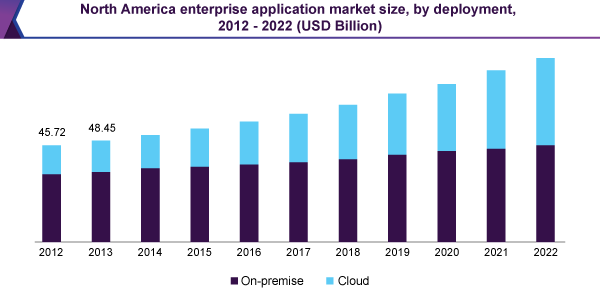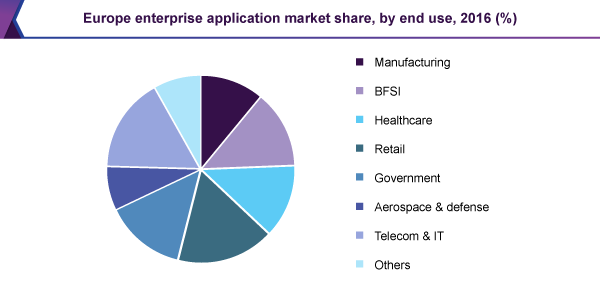- Home
- »
- Next Generation Technologies
- »
-
Enterprise Application Market Size, Share, 2012-2022, Industry ReportGVR Report cover
![Enterprise Application Market Size, Share & Trends Report]()
Enterprise Application Market Size, Share & Trends Analysis Report By Product, By End Use (BFSI, Healthcare, Manufacturing, Retail, Telecom & IT), By Deployment, By Region, And Segment Forecasts, 2012 - 2022
- Report ID: 978-1-68038-640-0
- Number of Report Pages: 100
- Format: PDF, Horizon Databook
- Historical Data: 2014-2016
- Forecast Period: 2018 - 2022
- Industry: Technology
Industry Insights
The global enterprise application market size was pegged at USD 164.46 billion in 2016 and is expected to develop at a CAGR of 7.8% over the forecast period. Enterprise application solutions such as business process management (BPM) and software configuration management (SCM) assist enterprises in tracking production from procurement to delivery to the end consumer and help in managing inventory. Implementation of these solutions enables accurate and real-time business information flow among departments in any enterprise.

An enterprise application is designed specifically to offer advantages such as efficient utilization of available industry insights and resources, customer engagement, and quality management. Thus, these solutions lead to fulfilling varied necessities of customers. In addition, the emergence of mobile device penetration and rising preference for remote access is anticipated to boost industry growth over the coming years.
Start-ups and small and medium-sized enterprises (SMEs) have adopted enterprise applications and solutions to control and monitor business processes, which are anticipated to contribute to revenue generation. Start-ups and SMEs have limited funding, as a result of which, investments on major infrastructure requirements and latest technologies are restricted. Hence, most SMEs opt for cloud-based services.
Easy availability and rising accessibility of open source solutions is anticipated to restrain industry growth over the projected period. Some of the commercially available open source solutions are CitrusDB, Magnolia, ProcessMaker, and FriFinans. High maintenance costs also threaten to hinder industry growth.
Product Insights
Enterprise resource planning (ERP) and customer relationship management (CRM) are anticipated to account for a significant share in the overall market, contributing a large chunk to the total revenue. In 2014, the customer relationship management segment accounted for 15.0% of the global market revenue. Benefits of automated back office operations such as inventory control, order management, production, and accounting offer accurate and real-time flow of information.
The content management system (CMS) segment is predicted to expand at a 13.0% CAGR over the forecast period owing to growing need for website content management. CMS solutions offer several benefits by converting unstructured data into structured data.
Business Intelligence (BI) solutions help provide improved efficiency, up-selling opportunities, and identify cross-selling and customer behavior insights. In 2014, the BI segment was valued at USD 15.91 billion and it is anticipated to expand significantly at a CAGR of 8.0% over the forecast period.
End-use Insights
The enterprise application market has been segmented on the basis of end use into telecom and information technology (IT), government, banking financial services, and insurance (BFSI), manufacturing services, retail, healthcare, aerospace and defense, travels, chemicals, oil and gas, and media and entertainment.

The healthcare segment is expected to exhibit a CAGR of 8.0% over the forecast period. Rapid adoption of enterprise applications in this sector can be attributed to increasing demand for real-time data transparency, which provides patient-centric healthcare solutions and systems with changing business models. Software vendors such as Infor, Oracle, and SAP provide solutions that improve overall performance, cost efficiency, patient safety, and quality of care.
Deployment Insights
The market for enterprise applications is segmented on the basis of deployment into on-premise and cloud. In 2014, on-premise solutions accounted for a majority of the overall revenue and is likely to continue dominating the global market.
However, cloud-based solutions are becoming increasingly popular among small-scale companies owing to budget constraints and the several benefits this platform offers. The cloud-based solution segment accounted for an estimated 31.0% of the market in 2014 and is estimated to gain substantial traction over the forecast period.
Regional Insights
North America accounted for a major share in the global market and is predicted to retain its dominance throughout the forecast period. Substantial growth in the regional market can be attributed changing business models with a more customer-centric approach and organizations concentrating on decreasing operational costs. Evolving organizational structures also present immense new growth opportunities for use of enterprise applications, thereby driving the regional market.
The Europe market for enterprise applications is estimated to exhibit an estimated CAGR of 6.0% over the course of the forecast period. Asia Pacific is anticipated to record considerable growth owing to increasing demand for cloud-based solutions, stemming primarily from rising number of start-ups and SMEs.
Enterprise Application Market Share Insights
Key players in the market include Oracle; Microsoft Corporation; Hewlett Packard (HP); IBM Corporation; QAD Inc.; SAP; IFS AB; Infor; and Epicor Software Corp.
To deliver a reliable customer experience, Oracle launched a series of innovations in 2015, under the banner of Oracle Marketing cloud. The company acquired Front Porch Digital in 2014, to strengthen its portfolio of content storage management solutions. IBM Corporation acquired 18 companies by investing over USD 8 billion to enhance its offerings of cloud-based solutions.
Segments Covered in the Report
This report forecasts revenue growth at global, regional, and country levels and provides an analysis on latest industry trends in each of the sub-segments from 2014 to 2022. For the purpose of this study, Grand View Research has segmented the global enterprise application market report on the basis of product, end use, deployment, and region:
-
Product Outlook (Revenue, USD Billion, 2012 - 2022)
-
CRM
-
ERP
-
SCM
-
Web Conferencing
-
BI
-
BPM
-
CMS
-
EAM
-
Others
-
-
End-use Outlook (Revenue, USD Billion, 2012 - 2022)
-
Manufacturing
-
BFSI
-
Healthcare
-
Retail
-
Government
-
Aerospace & Defense
-
Telecom & IT
-
Others
-
-
Deployment Outlook (Revenue, USD Billion, 2012 - 2022)
-
On-premise
-
Cloud
-
-
Regional Outlook (Revenue, USD Billion, 2012 - 2022)
-
North America
-
Europe
-
Asia Pacific
-
RoW
-
Share this report with your colleague or friend.
![gvr icn]()
NEED A CUSTOM REPORT?
We can customize every report - free of charge - including purchasing stand-alone sections or country-level reports, as well as offer affordable discounts for start-ups & universities. Contact us now
![Certified Icon]()
We are GDPR and CCPA compliant! Your transaction & personal information is safe and secure. For more details, please read our privacy policy.
We are committed towards customer satisfaction, and quality service.
"The quality of research they have done for us has been excellent."





